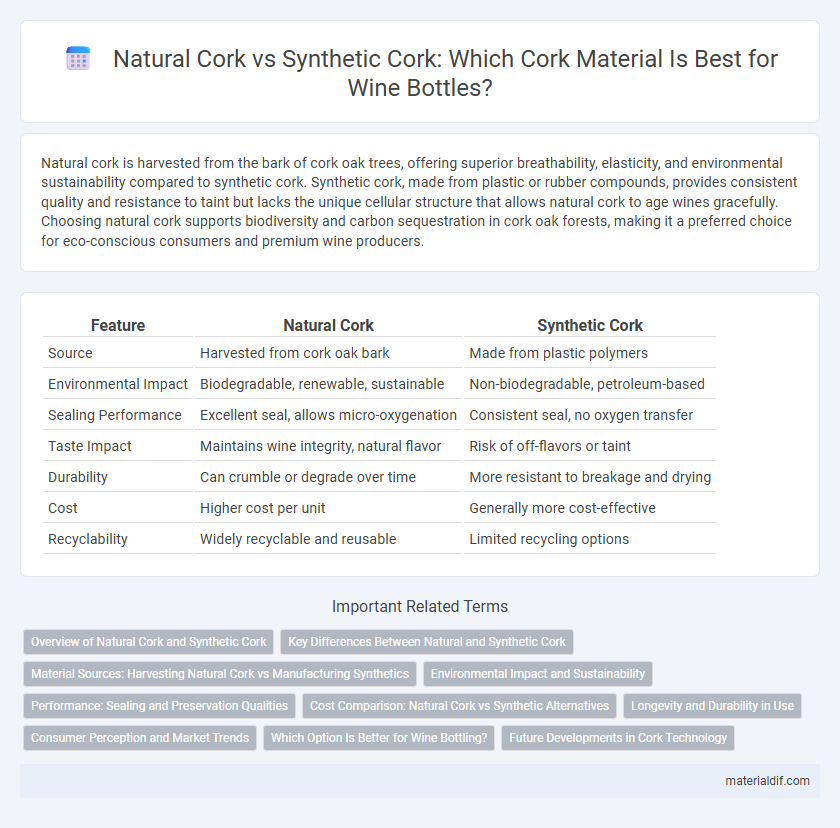Natural cork is harvested from the bark of cork oak trees, offering superior breathability, elasticity, and environmental sustainability compared to synthetic cork. Synthetic cork, made from plastic or rubber compounds, provides consistent quality and resistance to taint but lacks the unique cellular structure that allows natural cork to age wines gracefully. Choosing natural cork supports biodiversity and carbon sequestration in cork oak forests, making it a preferred choice for eco-conscious consumers and premium wine producers.
Table of Comparison
| Feature | Natural Cork | Synthetic Cork |
|---|---|---|
| Source | Harvested from cork oak bark | Made from plastic polymers |
| Environmental Impact | Biodegradable, renewable, sustainable | Non-biodegradable, petroleum-based |
| Sealing Performance | Excellent seal, allows micro-oxygenation | Consistent seal, no oxygen transfer |
| Taste Impact | Maintains wine integrity, natural flavor | Risk of off-flavors or taint |
| Durability | Can crumble or degrade over time | More resistant to breakage and drying |
| Cost | Higher cost per unit | Generally more cost-effective |
| Recyclability | Widely recyclable and reusable | Limited recycling options |
Overview of Natural Cork and Synthetic Cork
Natural cork is harvested from the bark of cork oak trees, offering sustainable, biodegradable, and renewable properties with excellent elasticity and breathability. Synthetic cork, typically made from plastics or rubber compounds, provides consistent performance and resistance to moisture but lacks the environmental benefits of natural cork. Both types serve as effective wine stoppers, with natural cork valued for traditional aging and synthetic cork preferred for immediate wine consumption.
Key Differences Between Natural and Synthetic Cork
Natural cork is harvested from the bark of cork oak trees, offering renewable, biodegradable, and breathable properties that enhance wine aging by allowing micro-oxygenation. Synthetic corks, made from plastic or rubber polymers, provide consistent sealing with greater resistance to cork taint and variability but lack the natural cellular structure essential for traditional cork performance. Key differences include their environmental impact, sealing reliability, and influence on wine preservation, with natural cork favored for sustainability and synthetic cork preferred for uniformity and cost-effectiveness.
Material Sources: Harvesting Natural Cork vs Manufacturing Synthetics
Natural cork is harvested from the bark of cork oak trees primarily found in Mediterranean regions, with sustainable practices allowing the bark to regenerate every 9 to 12 years. Synthetic corks are produced from plastic polymers, mainly polyethylene and ethylene vinyl acetate, derived from fossil fuels through petrochemical manufacturing processes. The renewable, biodegradable nature of natural cork contrasts with the energy-intensive production and limited recyclability of synthetic cork alternatives.
Environmental Impact and Sustainability
Natural cork, harvested from the bark of cork oak trees, offers superior environmental benefits due to its renewable and biodegradable properties, supporting biodiversity and carbon sequestration in Mediterranean ecosystems. Synthetic cork, typically made from plastic or foam, poses environmental challenges, including reliance on non-renewable petroleum resources and limited recyclability, leading to increased landfill waste and pollution. Sustainable wine closures prioritize natural cork to minimize ecological footprints and promote circular economy principles.
Performance: Sealing and Preservation Qualities
Natural cork offers superior sealing properties due to its cellular structure, allowing optimal elasticity and airtightness that effectively preserves wine by preventing oxidation. Synthetic corks, while consistent in size and free from cork taint, often lack the natural ability to adapt to bottle neck variations, potentially compromising the seal over time. Studies show that natural cork maintains preservation quality longer, retaining wine integrity and flavor stability better than most synthetic alternatives.
Cost Comparison: Natural Cork vs Synthetic Alternatives
Natural cork, harvested from the bark of living cork oak trees, offers a sustainable option with variable costs influenced by harvest cycles and quality grading, typically ranging from $0.50 to $2.00 per stopper. Synthetic corks, produced from plastic compounds, provide a more consistent price point generally between $0.30 and $1.00, making them a cost-effective alternative for large-scale wine producers. Despite higher upfront costs, natural cork maintains value through biodegradability and consumer preference for premium wines, influencing its market demand and price stability.
Longevity and Durability in Use
Natural cork offers exceptional longevity due to its cellular structure, which provides resilience and resistance to wear over time, making it ideal for long-term use in flooring and bottle stoppers. Synthetic cork, while more uniform in appearance and resistant to moisture and mold, tends to degrade faster under repeated stress and exposure to environmental factors. The durability of natural cork outperforms synthetic alternatives by maintaining elasticity and integrity through prolonged use, ensuring sustained performance and eco-friendly benefits.
Consumer Perception and Market Trends
Natural cork is often favored by consumers for its sustainability, biodegradability, and traditional craftsmanship, contributing to its premium appeal in the wine and flooring markets. Synthetic corks, made from plastics or polymers, offer consistency, mold resistance, and cost-effectiveness, appealing to budget-conscious buyers and mass-market producers. Market trends indicate a rising demand for natural corks driven by eco-conscious consumers, while synthetic corks maintain a steady presence due to their practicality and adaptability in various industries.
Which Option Is Better for Wine Bottling?
Natural cork, harvested from the bark of Quercus suber trees, provides superior breathability and a traditional aging process that enhances wine complexity, making it the preferred choice for high-quality wine bottling. Synthetic corks offer consistent sealing and reduce the risk of cork taint caused by TCA contamination but may lack the micro-oxygenation properties needed for long-term wine development. Winemakers prioritize natural cork for premium wines due to its environmental sustainability and proven track record in preserving wine integrity over time.
Future Developments in Cork Technology
Advancements in cork technology focus on enhancing the sustainability and performance of natural cork through nanotechnology and bioengineering, improving its durability and water resistance. Synthetic cork alternatives are evolving with eco-friendly materials like recycled polymers and biodegradable composites to reduce environmental impact. Innovations in hybrid cork products aim to combine the best properties of both natural and synthetic cork, targeting the wine, construction, and automotive industries.
Natural Cork vs Synthetic Cork Infographic

 materialdif.com
materialdif.com